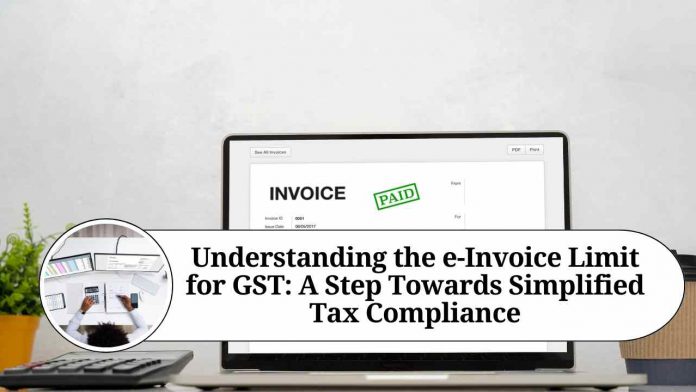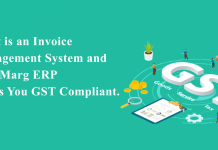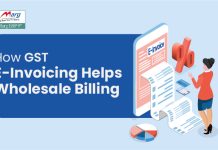Recent Updates on e-Invoicing:
10th May 2023
The CBIC has announced the introduction of the 6th phase of e-invoicing, aligning with the government’s goal of promoting a paperless GST system, reducing compliance expenses for businesses, and improving the efficiency of the GST system. Effective August 1st, 2023, companies with an annual turnover of ?5 crore or more since 2017-18 will be obligated to generate e-invoices.
Introduction
In recent years, governments around the world have been embracing digitization to streamline various processes, and taxation is no exception. In the Indian context, the implementation of the Goods and Services Tax (GST) brought about a significant shift in the way businesses manage their tax-related operations. One such development is the introduction of e-invoicing, which has gained momentum as a game-changer in simplifying tax compliance. However, it is essential to understand the e-invoice limit for GST to ensure compliance with the regulations effectively. In this blog post, we will delve into the concept of e-invoicing, explore its benefits, and shed light on the crucial aspect of the e-invoice limit.
What is e-Invoicing?
E-invoicing, or electronic invoicing, refers to the generation, exchange, and authentication of invoices digitally, eliminating the need for paper-based documentation. The e-invoicing system ensures standardization and automation in generating invoices, which enables seamless integration with the GST portal for efficient tax compliance. The GST Network (GSTN) developed the e-invoicing system, which aims to enhance transparency, reduce errors, and curb tax evasion.
Benefits of e-Invoicing:
Simplified Compliance:
E-invoicing automates the generation of invoices in a standardized format, reducing manual errors and making compliance more streamlined. It enables businesses to generate invoices in real-time, facilitating faster processing and reducing the risk of penalties due to non-compliance.
Faster Input Tax Credit (ITC) Processing:
The e-invoice system allows for automatic reconciliation of data with the GST portal, ensuring accurate and quicker processing of Input Tax Credit claims. This benefit greatly eases the burden on businesses and helps in managing working capital more efficiently.
Reduced Tax Evasion:
The e-invoicing system provides a robust mechanism to track transactions, making it harder for businesses to manipulate or under-report their sales. By promoting transparency and accountability, it helps in curbing tax evasion and creating a level playing field for businesses.
Understanding the e-Invoice Limit:
The e-invoice limit refers to the turnover threshold beyond which a business is required to generate e-invoices for their transactions. The introduction of e-invoicing in India was rolled out in a phased manner, starting with businesses having a turnover of ₹500 crore or more. However, to ensure a smooth transition, the government has gradually lowered the turnover threshold for e-invoicing implementation.
As of the current regulations, the e-invoice limit for GST stands at ₹50 crore in a financial year. This means that businesses with an annual turnover of ₹50 crore or more are required to generate e-invoices for all their B2B (Business-to-Business) transactions. It is important to note that this turnover limit is calculated based on the previous financial year’s turnover.
Compliance and Penalties:
Businesses falling within the ambit of the e-invoice limit must adhere to the e-invoicing requirements mandated by the government. Failing to comply with the e-invoicing regulations can attract penalties, including monetary fines and potential disruptions in business operations. It is crucial for businesses to assess their turnover and ensure timely implementation of e-invoicing to avoid non-compliance penalties.
Conclusion
The e-invoice limit for GST marks a significant milestone in India’s digital tax compliance journey. It emphasizes the government’s commitment to simplifying tax procedures and ensuring greater transparency in business transactions. By understanding the e-invoice limit and complying with the regulations, businesses can leverage the benefits of e-invoicing to streamline operations, enhance efficiency, and foster a more compliant tax ecosystem. As the government continues to push for digitization, embracing e-invoicing becomes an essential step for businesses of all sizes to stay ahead in the ever-evolving world of taxation.
Read more useful content:
Frequently Asked Questions (FAQs)
Q1: What is the e-invoice limit for GST?
A1: The e-invoice limit for GST is the turnover threshold beyond which businesses are required to generate e-invoices for their transactions. Currently, the e-invoice limit stands at ₹50 crore in a financial year.
Q2: How is the turnover calculated for determining the e-invoice limit?
A2: The turnover for determining the e-invoice limit is calculated based on the previous financial year’s turnover. Businesses need to assess their annual turnover and determine if it exceeds the e-invoice limit.
Q3: What happens if my business turnover exceeds the e-invoice limit?
A3: If your business turnover exceeds the e-invoice limit, you are required to generate e-invoices for all your B2B transactions. Failure to comply with this requirement may result in penalties and disruptions in business operations.
Q4: Are there any exemptions to the e-invoice limit?
A4: As of now, there are no exemptions to the e-invoice limit. Businesses with a turnover exceeding ₹50 crore are mandatorily required to generate e-invoices for their B2B transactions.
Q5: Can businesses voluntarily opt for e-invoicing if their turnover is below the e-invoice limit?
A5: Yes, businesses with a turnover below the e-invoice limit can voluntarily opt for e-invoicing. It can help them streamline their invoicing processes, enhance efficiency, and prepare for future growth.
Q6: Is the e-invoice limit subject to change?
A6: Yes, the e-invoice limit is subject to change based on government regulations and policies. It is important for businesses to stay updated with the latest announcements to ensure compliance.
Q7: Can businesses switch to e-invoicing if their turnover exceeds the e-invoice limit mid-year?
A7: Yes, businesses can switch to e-invoicing even if their turnover exceeds the e-invoice limit mid-year. It is advisable to implement the necessary changes and start generating e-invoices as soon as possible to comply with the regulations.
Q8: Are there any penalties for non-compliance with the e-invoice limit?
A8: Yes, non-compliance with the e-invoice limit can attract penalties. These penalties may include monetary fines and potential disruptions in business operations. It is essential for businesses to comply with the regulations to avoid such penalties.
Q9: How can businesses ensure compliance with the e-invoice limit?
A9: To ensure compliance with the e-invoice limit, businesses should assess their turnover, implement e-invoicing systems and processes, and generate e-invoices for all their B2B transactions. It is also recommended to stay updated with the latest guidelines and seek professional advice if needed.
Q10: What are the benefits of implementing e-invoicing even if my turnover is below the e-invoice limit?
A10: Implementing e-invoicing, even if your turnover is below the e-invoice limit, can bring various benefits such as improved efficiency, reduced errors, faster processing of Input Tax Credit (ITC), and enhanced transparency in business transactions. It can also prepare your business for future growth and compliance requirements.




















